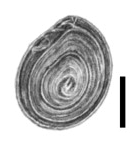Bithynia leachii
 From Wikipedia - Reading time: 6 min
From Wikipedia - Reading time: 6 min
| Bithynia leachii | |
|---|---|

| |
| A live Bithynia leachii | |
| Scientific classification | |
| Domain: | Eukaryota |
| Kingdom: | Animalia |
| Phylum: | Mollusca |
| Class: | Gastropoda |
| Subclass: | Caenogastropoda |
| Order: | Littorinimorpha |
| Superfamily: | Truncatelloidea |
| Family: | Bithyniidae |
| Genus: | Bithynia |
| Species: | B. leachii
|
| Binomial name | |
| Bithynia leachii | |
| Synonyms | |
| |
Bithynia leachii is species of small freshwater snail with an operculum, an aquatic prosobranch gastropod mollusk in the family Bithyniidae.
Distribution
[edit]It is a Palearctic species found in North Africa and Europe to East Siberia.
- Czech Republic – near Morava River and near Thaya river in the southernmost Moravia near Hlohovec, Kostice and Tvrdonice,[3][4] critically endangered (CR)[5]
- Germany – high endangered (Stark gefährdet)[6]
- Netherlands[7]
- Poland
- Slovakia – in Danube drainage basin (mainly in Žitný ostrov) and in Tisza drainage basin[4]
- Sweden
- Great Britain
- Ireland
- Hungary[8]
Shell description
[edit]The width of the shell is 3–7 mm. The height of the shell is 4–8 mm. The colour is brown or grey. There are 4 to 4.5 very convex whorls forming a short cone with a very deep suture in comparison to Bithynia tentaculata. The spire is shorter and less sharp than in Bithynia tentaculata. The aperture and operculum upside are smoothly rounded. The aperture is without a sharp point on the upper corner.[9]
 |
 |
 |
Habitat
[edit]This species requires clean, calcium-rich water, which is slow-running and thickly weeded.[10]
Parasites
[edit]Parasites of Bithynia leachii include:
- Prosthogonimidae: Bithynia leachii can act as first intermediate host for Prosthogonimus ovatus.[11]
- Opisthorchiidae: Bithynia leachii serves as the first intermediate host for Opisthorchis felineus.[12]
References
[edit]- ^ Vavrova L., Cianfanelli S., Prie V., Georgiev D. & Ghamizi M. (2010). "Bithynia leachii". The IUCN Red List of Threatened Species. Version 2014.2. <www.iucnredlist.org>. Downloaded on 05 August 2014.
- ^ Sheppard R. (1823). "Descriptions of seven new British land and fresh-water shells, with observations upon many other species, including a list of such as have been found in the county of Suffolk". Transactions of the Linnean Society of London 14(1): 148–170, page 152.
- ^ Beran L. & Horsák M. (2009) "Distribution of Bithynia leachii (Sheppard, 1823) and Bithynia troschelii (Paasch, 1842) (Gastropoda: Bithyniidae) in the Czech Republic". Malacologica Bohemoslovaca 8: 19–23. PDF.
- ^ a b (in Czech) Horsák M., Juřičková L., Beran L., Čejka T. & Dvořák L. (2010). "Komentovaný seznam měkkýšů zjištěných ve volné přírodě České a Slovenské republiky. [Annotated list of mollusc species recorded outdoors in the Czech and Slovak Republics]". Malacologica Bohemoslovaca, Suppl. 1: 1–37. PDF.
- ^ Red List of the molluscs (Mollusca) of the Czech Republic
- ^ (in German) Glöer P. & Meier-Brook C. (2003) Süsswassermollusken. DJN, pp. 134, page 106, ISBN 3-923376-02-2
- ^ (in Dutch) Bithynia leachii — Anemoon
- ^ Glöer P. & Fehér Z. (2004). "Bithynia leachii (Sheppard, 1823) and Bithynia troschelii (Paasch, 1842) in Hungary (Prosobranchia: Bithyniidae)". Annales historico-naturales Musei nationalis hungarici 96: 285–297.
- ^ "Species summary for Bithynia leachii". AnimalBase, last change 26 October 2013, accessed 4 June 2014.
- ^ Horst Janus (1965). The young specialist looks at land and freshwater molluscs. Burke, London.
- ^ "Prosthogonimus ovatus", as Bithynia leachei (sic!), accessed July 23, 2011.
- ^ Gajadhar A. A. (2015). Foodborne Parasites in the Food Supply Web: Occurrence and Control. Woodhead Publishing, 482 pp., page 297. Google books.
External links
[edit]- Bithynia leachii Species account and photograph at Mollusc Ireland.
 KSF
KSF
